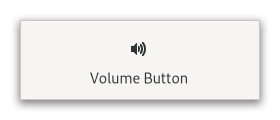| Copyright | Will Thompson and Iñaki García Etxebarria |
|---|---|
| License | LGPL-2.1 |
| Maintainer | Iñaki García Etxebarria |
| Safe Haskell | Safe-Inferred |
| Language | Haskell2010 |
GI.Gtk.Objects.VolumeButton
Description
GtkVolumeButton is a GtkScaleButton subclass tailored for
volume control.

Synopsis
- newtype VolumeButton = VolumeButton (ManagedPtr VolumeButton)
- class (GObject o, IsDescendantOf VolumeButton o) => IsVolumeButton o
- toVolumeButton :: (MonadIO m, IsVolumeButton o) => o -> m VolumeButton
- volumeButtonNew :: (HasCallStack, MonadIO m) => m VolumeButton
- constructVolumeButtonUseSymbolic :: (IsVolumeButton o, MonadIO m) => Bool -> m (GValueConstruct o)
- getVolumeButtonUseSymbolic :: (MonadIO m, IsVolumeButton o) => o -> m Bool
- setVolumeButtonUseSymbolic :: (MonadIO m, IsVolumeButton o) => o -> Bool -> m ()
Exported types
newtype VolumeButton Source #
Memory-managed wrapper type.
Constructors
| VolumeButton (ManagedPtr VolumeButton) |
Instances
| Eq VolumeButton Source # | |
Defined in GI.Gtk.Objects.VolumeButton | |
| GObject VolumeButton Source # | |
Defined in GI.Gtk.Objects.VolumeButton | |
| ManagedPtrNewtype VolumeButton Source # | |
Defined in GI.Gtk.Objects.VolumeButton Methods toManagedPtr :: VolumeButton -> ManagedPtr VolumeButton | |
| TypedObject VolumeButton Source # | |
Defined in GI.Gtk.Objects.VolumeButton | |
| HasParentTypes VolumeButton Source # | |
Defined in GI.Gtk.Objects.VolumeButton | |
| IsGValue (Maybe VolumeButton) Source # | Convert |
Defined in GI.Gtk.Objects.VolumeButton Methods gvalueGType_ :: IO GType gvalueSet_ :: Ptr GValue -> Maybe VolumeButton -> IO () gvalueGet_ :: Ptr GValue -> IO (Maybe VolumeButton) | |
| type ParentTypes VolumeButton Source # | |
Defined in GI.Gtk.Objects.VolumeButton type ParentTypes VolumeButton = '[ScaleButton, Widget, Object, Accessible, AccessibleRange, Buildable, ConstraintTarget, Orientable] | |
class (GObject o, IsDescendantOf VolumeButton o) => IsVolumeButton o Source #
Type class for types which can be safely cast to VolumeButton, for instance with toVolumeButton.
Instances
| (GObject o, IsDescendantOf VolumeButton o) => IsVolumeButton o Source # | |
Defined in GI.Gtk.Objects.VolumeButton | |
toVolumeButton :: (MonadIO m, IsVolumeButton o) => o -> m VolumeButton Source #
Cast to VolumeButton, for types for which this is known to be safe. For general casts, use castTo.
Methods
Click to display all available methods, including inherited ones
Methods
actionSetEnabled, activate, activateAction, activateDefault, addController, addCssClass, addMnemonicLabel, addTickCallback, allocate, bindProperty, bindPropertyFull, childFocus, computeBounds, computeExpand, computePoint, computeTransform, contains, createPangoContext, createPangoLayout, disposeTemplate, dragCheckThreshold, errorBell, forceFloating, freezeNotify, getv, grabFocus, hasCssClass, hasDefault, hasFocus, hasVisibleFocus, hide, inDestruction, initTemplate, insertActionGroup, insertAfter, insertBefore, isAncestor, isDrawable, isFloating, isFocus, isSensitive, isVisible, keynavFailed, listMnemonicLabels, map, measure, mnemonicActivate, notify, notifyByPspec, observeChildren, observeControllers, pick, queueAllocate, queueDraw, queueResize, realize, ref, refSink, removeController, removeCssClass, removeMnemonicLabel, removeTickCallback, resetProperty, resetRelation, resetState, runDispose, shouldLayout, show, sizeAllocate, snapshotChild, stealData, stealQdata, thawNotify, translateCoordinates, triggerTooltipQuery, unmap, unparent, unrealize, unref, unsetStateFlags, updateNextAccessibleSibling, updateProperty, updateRelation, updateState, watchClosure.
Getters
getAccessibleParent, getAccessibleRole, getActive, getAdjustment, getAllocatedBaseline, getAllocatedHeight, getAllocatedWidth, getAllocation, getAncestor, getAtContext, getBounds, getBuildableId, getCanFocus, getCanTarget, getChildVisible, getClipboard, getColor, getCssClasses, getCssName, getCursor, getData, getDirection, getDisplay, getFirstAccessibleChild, getFirstChild, getFocusChild, getFocusOnClick, getFocusable, getFontMap, getFontOptions, getFrameClock, getHalign, getHasTooltip, getHeight, getHexpand, getHexpandSet, getLastChild, getLayoutManager, getMapped, getMarginBottom, getMarginEnd, getMarginStart, getMarginTop, getMinusButton, getName, getNative, getNextAccessibleSibling, getNextSibling, getOpacity, getOrientation, getOverflow, getPangoContext, getParent, getPlatformState, getPlusButton, getPopup, getPreferredSize, getPrevSibling, getPrimaryClipboard, getProperty, getQdata, getRealized, getReceivesDefault, getRequestMode, getRoot, getScaleFactor, getSensitive, getSettings, getSize, getSizeRequest, getStateFlags, getStyleContext, getTemplateChild, getTooltipMarkup, getTooltipText, getValign, getValue, getVexpand, getVexpandSet, getVisible, getWidth.
Setters
setAccessibleParent, setAdjustment, setCanFocus, setCanTarget, setChildVisible, setCssClasses, setCursor, setCursorFromName, setData, setDataFull, setDirection, setFocusChild, setFocusOnClick, setFocusable, setFontMap, setFontOptions, setHalign, setHasTooltip, setHexpand, setHexpandSet, setIcons, setLayoutManager, setMarginBottom, setMarginEnd, setMarginStart, setMarginTop, setName, setOpacity, setOrientation, setOverflow, setParent, setProperty, setReceivesDefault, setSensitive, setSizeRequest, setStateFlags, setTooltipMarkup, setTooltipText, setValign, setValue, setVexpand, setVexpandSet, setVisible.
new
Arguments
| :: (HasCallStack, MonadIO m) | |
| => m VolumeButton | Returns: a new |
Deprecated: (Since version 4.10)This widget will be removed in GTK 5
Creates a GtkVolumeButton.
The button has a range between 0.0 and 1.0, with a stepping of 0.02.
Volume values can be obtained and modified using the functions from
ScaleButton.
Properties
useSymbolic
Whether to use symbolic icons as the icons.
Note that if the symbolic icons are not available in your installed theme, then the normal (potentially colorful) icons will be used.
constructVolumeButtonUseSymbolic :: (IsVolumeButton o, MonadIO m) => Bool -> m (GValueConstruct o) Source #
Construct a GValueConstruct with valid value for the “use-symbolic” property. This is rarely needed directly, but it is used by new.
getVolumeButtonUseSymbolic :: (MonadIO m, IsVolumeButton o) => o -> m Bool Source #
Get the value of the “use-symbolic” property.
When overloading is enabled, this is equivalent to
get volumeButton #useSymbolic
setVolumeButtonUseSymbolic :: (MonadIO m, IsVolumeButton o) => o -> Bool -> m () Source #
Set the value of the “use-symbolic” property.
When overloading is enabled, this is equivalent to
setvolumeButton [ #useSymbolic:=value ]